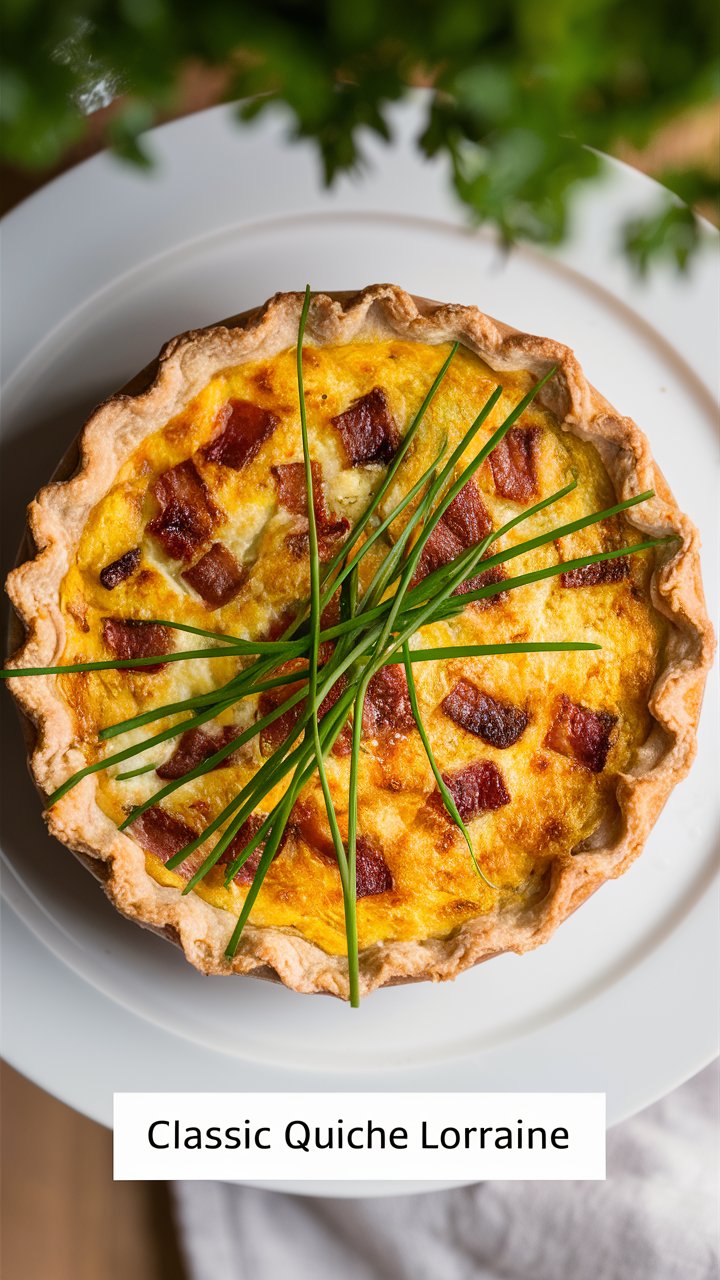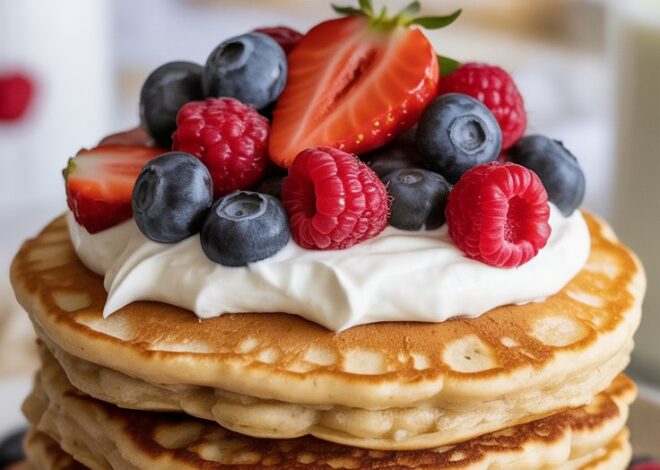
How to Make Classic Quiche Lorraine with a Silky Custard and Flaky Crust 2025
Quiche Lorraine is much more than a brunch dish—it’s a culinary symbol of French elegance, combining silky custard, smoky bacon, tender onions, and melted cheese nestled in a flaky, golden crust. Whether served piping hot from the oven, at room temperature, or even chilled, it delights every time. In this article, we go deep—ingredients, technique, tips, variations, and serving ideas—to make your quiche better than any you’ve had before.
1. What Is Quiche Lorraine? (History & Origins)
“Quiche” comes from the German word Kuchen (cake), and the dish has roots in the border region between France and Germany (Lorraine). Over centuries, it evolved into a savory tart filled with eggs, cream, and bits of pork (like bacon or lardons).
Originally modest and rural, Quiche Lorraine became popularized in French cafés and eventually traveled globally. Today, while many versions exist with vegetables, seafood, or even crustless styles, the classic version retains its elegant simplicity: custard + bacon + cheese in a pastry shell.
Key hallmarks of the traditional Quiche Lorraine:
- A rich egg-and-cream base (not too heavy, not too wet)
- Crisp, smoky pork (traditionally lardons, now often bacon)
- Minimal additions—no overpowering vegetables
- A well-baked, crisp crust that resists sogginess
In other words: simplicity, balance, and technique.
2. Why This Version Works (Flavor & Texture Principles)
Before diving into the recipe, let’s understand the rationale behind each major component. Knowing this helps you adapt (or recover) with confidence.
- Custard balance: The ratio of egg to cream (or half-and-half) should yield a custard that sets cleanly without being rubbery. Too much liquid leads to soggy or wobbly interiors; too little yields dryness.
- Crust sealing: The crust is pre-baked (blind baking) and brushed with egg white to create a barrier so moisture from the filling doesn’t make it soggy.
- Ingredient timing: Bacon fat is used to sauté onions—this layers flavor. Also, letting cooked bacon and onions cool slightly prevents them from “cooking” the egg mixture when added.
- Even baking & resting: Baking slowly at moderate heat and letting the quiche rest afterward helps the custard fully set without cracking.
- Ingredient quality: Freshly shredded cheese melts better; good eggs and fresh cream give depth.
By following these principles, your quiche will have a rich, silky center, smoky pockets of bacon, and a firm, flaky crust.
3. Ingredients: What You’ll Need (and Why)
Here’s a refined ingredient list, with notes and alternative options.
Pastry:
- 1 (≈ 230–250 g) all-butter pie crust (or shortcrust pastry)
- You may use frozen store-bought, but butter-based is superior in flavor.
- Alternatively, a portion of butter + a portion of fat (like vegetable shortening) can balance flakiness and softness.
Filling:
- 200–225 g bacon (or lardons), chopped
- 1 medium yellow onion, finely diced
- 4 large eggs
- 1¾ cups (≈ 420 ml) half-and-half (or mix 1 cup cream + ¾ cup whole milk)
- 1 tsp kosher salt (or adjust to taste)
- ¼ tsp freshly ground black pepper
- ¼ tsp smoked paprika (optional, for a subtle smoky warmth)
- ⅛ tsp freshly grated nutmeg (adds subtle background warmth)
- 1 cup (≈ 100 g) shredded Gruyère cheese (or Swiss / Emmental)
- Fresh parsley or chives, chopped (for garnish)
Optional / Alternative Add-Ins:
- Mushrooms (sliced, sautéed)
- Spinach (blanched and squeezed)
- Leeks (white part, thinly sliced)
- Swiss or sharp cheddar cheese (in place of Gruyère)
4. How to Make It: Step-by-Step Instructions
Here’s a detailed, easy-to-follow method:
Step 1: Prepare & Chill the Crust
- Roll out your pie crust (on a lightly floured surface) to about 12″ (30 cm) diameter.
- Transfer to a 9- or 10-inch (23–25 cm) tart pan or deep pie dish. Press gently to fit, trimming excess.
- Chill in freezer for 20–30 minutes (this helps prevent shrinkage during baking).
Step 2: Blind-Bake the Crust
- Preheat oven to 350 °F (≈ 175 °C).
- Line crust with parchment, fill with pie weights (beans or rice suffice).
- Bake for 25–30 minutes, until edges are lightly golden and the base is set.
- Remove parchment and weights.
- Brush the interior of the crust with beaten egg white (just enough for a thin seal). Return to oven 5 minutes more to firm slightly.
- Let cool slightly (5–10 minutes) while you prepare fillings.
Step 3: Cook Bacon & Onions
- In a skillet over medium heat, cook the chopped bacon until crispy (fat rendered). Remove bacon with slotted spoon; reserve some fat.
- In the same skillet (using bacon fat), sauté diced onion until translucent-golden (not browned).
- Remove onions; drain both cooked bacon and onions on paper towel to remove excessive fat.
Step 4: Whisk the Custard
- In a large mixing bowl, whisk together eggs, half-and-half (or cream/milk mix), salt, pepper, smoked paprika, and nutmeg until smooth. Whisk enough to incorporate air lightly (but not frothy).
- Stir in shredded cheese, then gently fold in the cooked bacon and onions.
Step 5: Fill & Bake
- Place the crust on a baking sheet (to catch spills).
- Pour the custard mixture into the crust, gently pressing the bits down so the surface is as level as possible.
- Bake in the 350 °F (175 °C) oven for 45–55 minutes, or until the center is just set (slight jiggle but not liquid). A knife inserted near center should come out mostly clean, with moist crumbs, not raw.
- If the edges brown too quickly, tent with foil.
Step 6: Rest & Serve
- Let the quiche rest 15–20 minutes before slicing—this helps the custard fully set.
- Garnish with chopped parsley or chives before serving.
- Serve warm or at room temperature (or chilled, if you prefer later).
5. Pro Tips & Troubleshooting
Here are tips to elevate your quiche and rescue possible problems.
| Problem / Concern | Tip / Solution |
|---|---|
| Soggy crust | Ensure a good blind bake and egg-white seal; don’t overfill; use moderate heat. |
| Cracks in custard | Don’t overbake; rest it—carryover heat continues to set the center. |
| Custard too runny | Possible causes: too much liquid, underbaking, or over-moist ingredients (e.g. wet spinach). Bake a little longer, or reduce cream ratio slightly. |
| Burning crust edges | Use a crust shield or foil tent after edges reach golden. |
| Uneven browning | Rotate the quiche halfway through baking for more even exposure. |
| Crust shrinkage | Chill the pastry well before baking and avoid stretching it in the pan. |
Other Pro Tips:
- Use freshly shredded cheese (grated just before use)—it melts better and doesn’t have anti-caking agents.
- Bring filling ingredients (eggs, cream) close to room temp—cold ingredients can cause thermal shock.
- After cooking bacon, reserve just enough fat to sauté onions; discard excess to reduce greasiness.
- Let the filling chill slightly before baking if ingredients are warm—avoids prematurely cooking eggs.
- After baking, cooling on a wire rack (not in the pan) helps air circulate and prevents soggy bottoms.
6. Variations & Add-In Ideas
While the classic version is beloved, you can tailor it to your preferences. These variations are all grounded in sound technique:
- Vegetable Quiche Lorraine: Omit bacon; use sautéed mushrooms, leeks, spinach (well drained), etc.
- Cheese swap: Use sharp cheddar, Emmental, Comté, or a blend.
- Crustless quiche: Skip the crust; pour custard into a well-greased pan and reduce baking time by ~10 minutes.
- Mini quiches / quiche muffins: Use a muffin tin; reduce bake time (20–25 min) depending on size.
- Smoked salmon version: Add flaked smoked salmon (careful of moisture) and omit bacon.
- Herb accents: Tarragon, thyme, or dill complement the flavors nicely (use sparingly).
Always pay attention to moisture content (e.g. vegetables should be well drained) and adjust baking time accordingly.
7. Serving, Storage & Reheating
Serving Suggestions
- A crisp green salad (vinaigrette) balances richness.
- Roasted asparagus, cherry tomatoes, or sautéed greens are elegant sides.
- Fresh fruit or a fruit salad adds contrast.
- Bread or croutons for extra texture.
- For brunch, serve alongside mimosas or fresh juices.
Storage
- Cover the cooled quiche and refrigerate for up to 4 days.
- For freezing: slice, wrap tightly in plastic + foil, and freeze for up to 2 months. Thaw overnight in fridge.
Reheating
- Oven (preferred): 325 °F (160 °C) until warmed through (10–15 min for slices, ~25 min for whole).
- Microwave: use low/medium setting; may soften crust.
- Serve slightly warm or room temp for best texture.
8. Nutritional Notes (Estimates)
Here’s an approximate breakdown per slice (assuming 8 slices for a 9-inch quiche):
| Nutrient | Estimate |
|---|---|
| Calories | ~ 320-380 kcal |
| Protein | ~ 12-15 g |
| Fat | ~ 24-28 g |
| Carbohydrates | ~ 12-15 g |
| Fiber | ~ 0.5-1 g |
| Sodium | Moderate to high (due to bacon and cheese) |
These are rough values—depending on ingredients (cheese type, cream vs milk, bacon fat trimmed), values will vary. If you use leaner bacon or lighter dairy, you can reduce calories a bit.
9. Frequently Asked Questions
Q. Can I use only milk (no cream)?
Yes—but full-fat milk may result in a slightly softer custard. A combination (e.g. ½ cream + ½ milk) retains richness and structure.
Q. Can I make this entirely in advance?
Yes. Bake fully, let cool, then refrigerate. Reheat gently in the oven before serving.
Q. My center is still jiggly—did I underbake?
Possibly. But slight jiggle is okay; quiche continues to set as it cools. If very liquid, bake a few more minutes.
Q. Can I use a metal vs glass baking dish?
Yes, but glass retains more heat and may require slightly lower temperature or shorter bake to prevent over-browning at edges.
Q. Why brush with egg white?
It forms a seal preventing the custard from soaking into the crust, preserving crispness.
Q. What’s the ideal pan size?
A 9- or 10-inch tart pan or deep 9-inch pie dish works best. Too big leads to shallow filling; too small may overflow.
Q. Crust is browning too fast—what to do?
Use a foil shield or ring after edges brown. Rotate pan for even color.
10. Final Thoughts & Encouragement
Crafting a stellar Classic Quiche Lorraine is about balance: not too wet, not too firm; smoky bacon flavor without overpowering; a crust that stays crisp; and a custard that’s silky but holds shape. The more you understand why each step matters, the more you can adapt or rescue when things don’t go perfectly.
I encourage you to try this version once, notice where your kitchen differs (oven heat, ingredient moisture, pan type), and adjust subtly. Before long, your quiche will become your signature.


